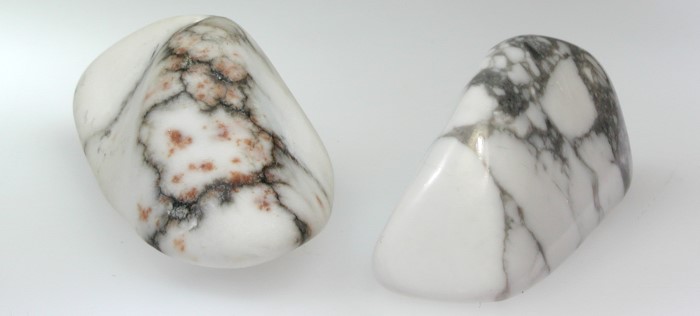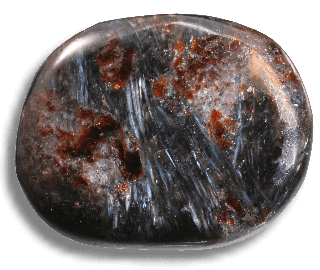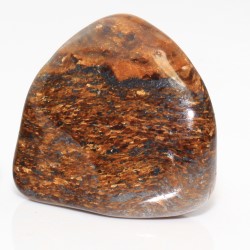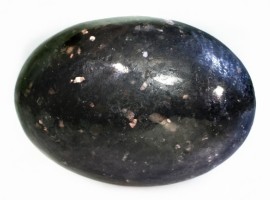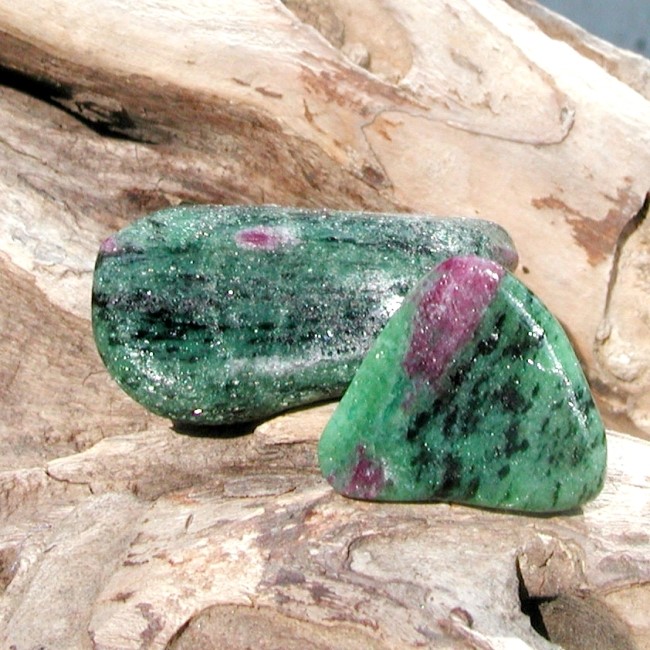The mineral howlite is not well known because of its beauty, but has a dubious reputation of being an excellent imitation for turquoise when artificially dyed. Especially in the 60s to 90s of the last century large quantities of these fake turquoises were offered. After the deposits dried up, genuine howlite has become a rarity in the gemstone sector. As a substitute material, the mineral magnesite is available, which misleadingly is declared as "howlite" or (in the colored state) as "turquoise".
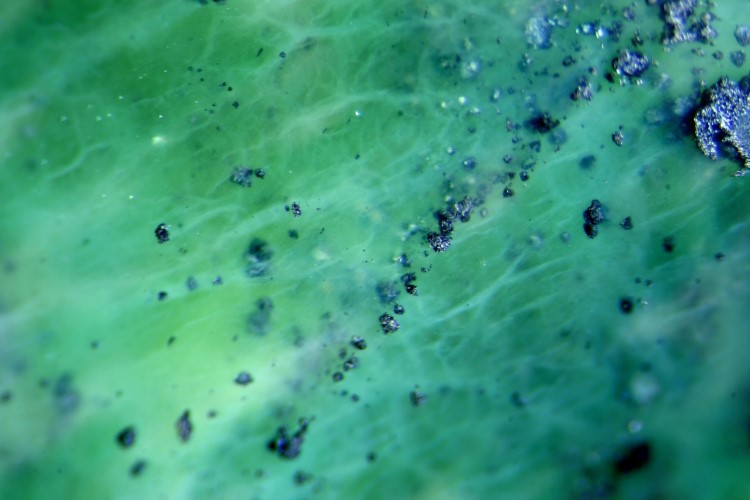
Bright, net-like structures and magnetic, black inclusions in an antigorite serpentinite
Image: K. Sieber, www.makrogalerie.de
When scientists analyzed the chemical composition of chinese "Jade" in the 19th century, they discovered that at least two, completely different minerals were in circulation. First, the mineral jadeite from the pyroxene group. On the other hand finely matted minerals of the (ferro-) actinolite - tremolite solid solution series (Fig. 3), called "nephrite". Therefore it is important to keep in mind that the term jade (see: What is »JADE« ?) is not a mineral name, but a cultural name.
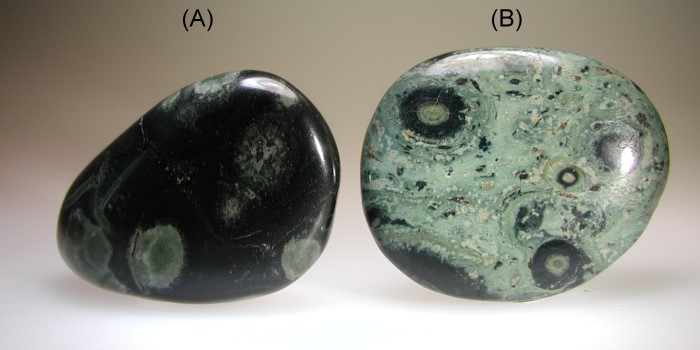
»Nebula Stone« (A) and »Kambaba Stone« (B) are varieties of a volcanic rock called »Eldarite« in the trade.
Image: K. Sieber, www.makrogalerie.de
under the trade name »Eldarite« two typs of rocks are offered. The first variant comes from Mexico and consists of a (nearly) black rock with green dots and circles (A). Some people probably felt reminded of galaxies and star nebulae when looking at this rock, which is why they named it »Nebula Stone«. The second variant (B) comes from Madagascar and has usually substantially more green components. In America it is known under the name »Kambaba Jasper«, in Germany it is rather traded under the name »Kabamba Stone«. For decades »Nebula Stone«, »Kabamba Stone« and »Eldarite« were used as synonyms.
Although they are clearly distinguishable on close inspection, the minerals astrophyllite and anthophyllite are often confused. Both specimens occur in the form of shiny, iridescent fibrous aggregates. Together with other minerals, they often form interestingly patterned rocks. One of these is an anthophyllite schist from Sweden.
Anthophyllite (-Schist)
Anthophyllite belongs to the amphibole mineral group and is chemically related to the minerals actinolite and tremolite, known in a fine-fibrous, felted form as "nephrite jade". Similar to these, anthophyllite readily forms stemmed to radiating fibrous aggregates.
_____________________
»Bronzite-Pyroxenite«
In modern mineralogy, "bronzite" is no longer regarded as a mineral in its own right, but as an iron-bearing variety of the mineral enstatite (so-called "Ferro-Enstatite", abbreviated: "Fe-Enstatite", (Mg,Fe)2[Si2O6],). Fe-Enstatite of the variety Bronzite contains 5 - 15% iron (in relation to magnesium) and belongs to the mineral group of pyroxenes. This group comprises single chain silicates with the basic component [Si2O6].
Many rocks, previously known primarily in the stonemasonry industry, are recently seen in the mineral trade as polished or tumbled stones. This development is undoubtedly an enrichment for lovers of beautiful rocks. Unfortunately, these decorative rocks are rarely labeled with a mineralogically/petrographically correct name. This is also the case with a dark, almost black rock with copper-colored sprinkles, which is often wrongly offered in the mineral trade under the name "Nuumite".
Bronzite-Gabbro (Norite)
The rocks garnet-pyroxenite, garnet-peridotite and eclogite, all with a red-green speckled appearance, look very similar and yet are very different. They can occur side by side at the same locality and are easily confused. In the past they were only interesting for stonemasons, but in the last years they are increasingly offered as tumbled stones and gemrocks.
Garnet-Pyroxenite
Pyroxenites are igneous rocks consisting of more than 50% pyroxene. These rocks form deep within the Earth's interior in the upper mantle and are brought into the upper crust either by rock displacements or by the intrusion of liquid magma into existing rock layers. One of the popular pyroxenite gemrocks are e.g. »Bronzite-Pyroxenite«.
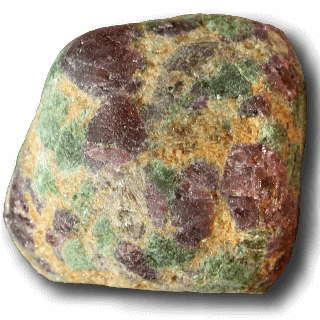
Fig 1: This colorful rock is neither an eclogite nor a garnet peridotite, but a GARNET - PYROXENITE (green: diopside, yellow: enstatite, red: pyrope garnet).
Image: K. Sieber, www.makrogalerie.de
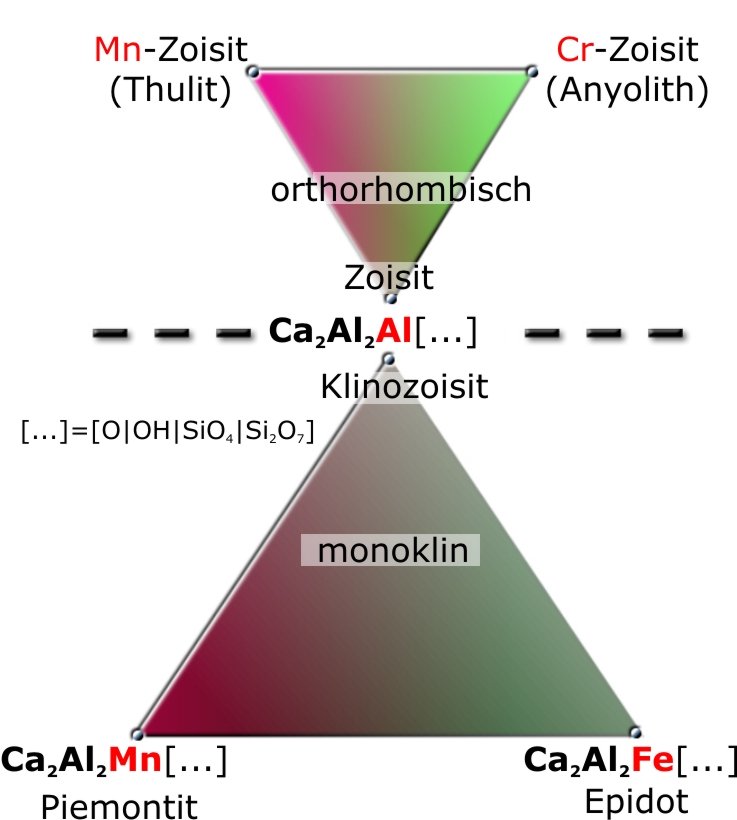
Fig. 1: Chemical composition of some minerals from the epidote-zoisite group
Grafic: © EPI-Institut
_____________________
The mineral zoisite is a calcium (Ca) - aluminum (Al) silicate with the formula Ca2Al3[O|OH|SiO4|Si2O7]. It is capable to form single large crystals, but also massive rock bodies. By incorporation of the element manganese (Mn) into the crystal lattice, zoisite gets a pink to brown-red color (trade name: »Thulite«). Chromium Turns tho color of the mineral into green (trade name: »Anyolite«) and vanadium into blue (trade name: »Tanzanite«). Zoisite forms crystal shapes with orthorhombic symmetry.
The calcium-aluminum silicate zoisite is capable of forming rocks, e.g. pink »Thulitite« or green »Anyolite«. The latter often bears large ruby crystals. As a whole rock it is optically confusable with green fuchsite mica, which can also contain ruby.
Ruby-Zoisite (»Anyolite«)
_____________________
The name »Anyolite« (after the Masai word for "green") stands for a mineral mixture of rock-forming green opaque to translucent zoisite, black hornblende amphibole and opaque to translucent rubies. It is also called "ruby zoisite" according to its mineral composition. The green color is caused by the element chromium.
Large quantities of blue or green Calcite / Aragonite, often with indication of origin China, are falsely offered as Hemimorphite or Smithsonite. A comparison of the chemical and physical properties shows the differences:
Hemimorphite
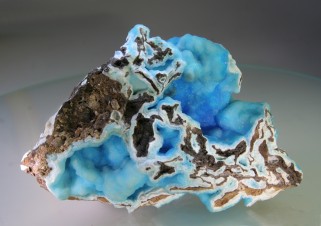
Fig.1: Natural Hemimorphite typically grown as crusty aggregates
Image: K. Sieber, www.makrogalerie.de
Genuine Hemimorphite is a relatively rare mineral. It forms in the oxidation zone of sulfidic lead-zinc deposits. On the basis of its physical and chemical properties Hemimorphite can be distinguished from its imitations without difficulty.
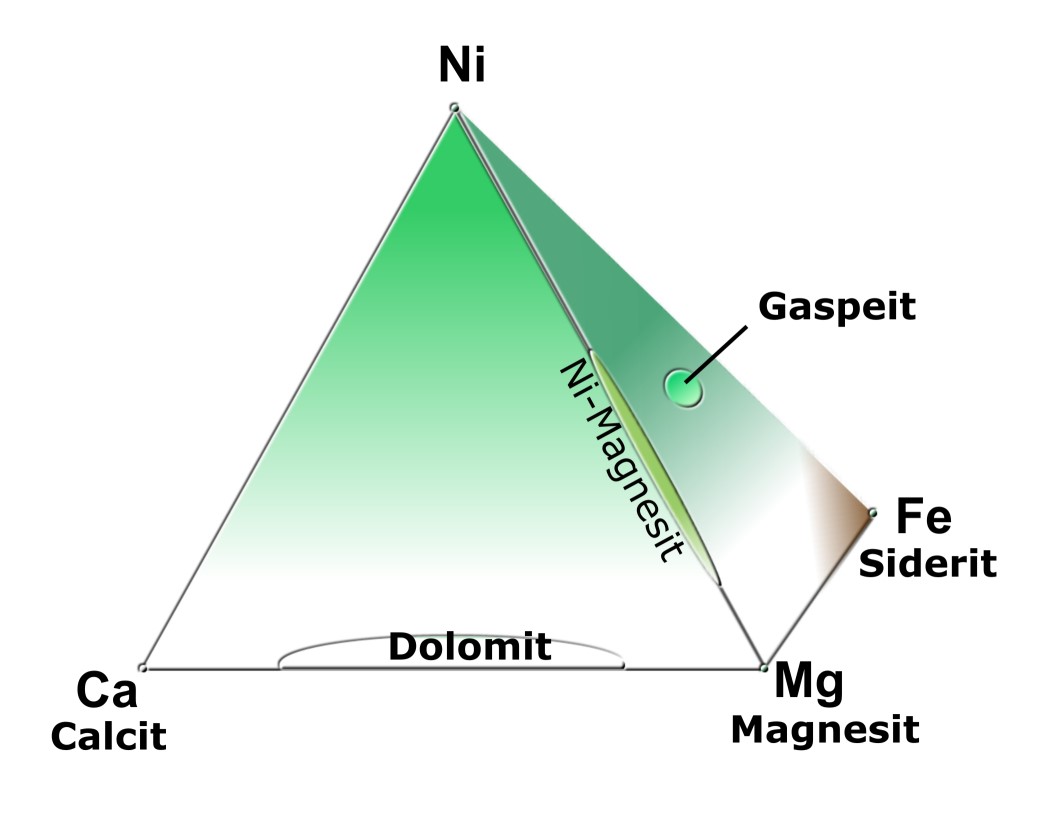
Fig. 1: Chemical composition of Ca-Mg-Fe-Ni carbonates
Grafic © EPI
_____________________
The magnesium carbonate magnesite (MgCO3) in a well-crystallized, pure state is a colorless mineral. As such it occurs quite rarely in nature. Mostly it occurs in large masses or in bulbous aggregates as a rock-forming mineral. The most common color is white or gray, more rarely beige (trade name: »Ivoryite«) or green. Green hues result from the incorporation of nickel or nickel-bearing minerals.
Compared to the widespread, well-crystallized, transparent representatives of its kind, coarse fluorite is a little noticed mineral. Its relatively inconspicuous and "atypical" appearance, often leads to confusion with other minerals.
Many of these derby fluorites are very hydrous and are therefore called Hydro-Fluorite. (Hydro-) Fluorite (CaF2 x H2O) has a hardness of 4 on the Mohs scale and a density of 3.1 - 3.3. The most common variety commes in purple color.
Hydrofluorite as imitation for »Lavender Jade«
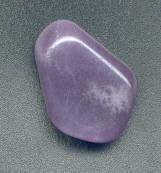
Hydrofluorite offered as »Lavender Jade«
Foto: EPI




